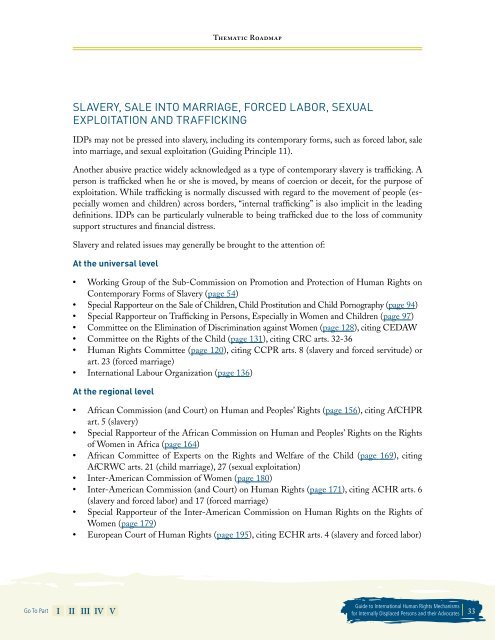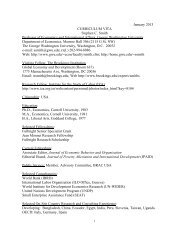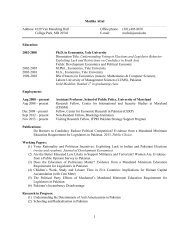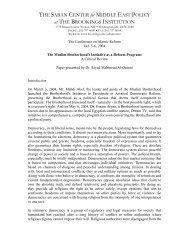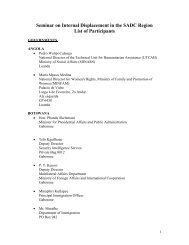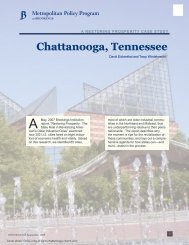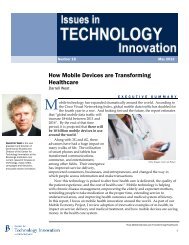Guide to International Human Rights Mechanisms - Brookings
Guide to International Human Rights Mechanisms - Brookings
Guide to International Human Rights Mechanisms - Brookings
You also want an ePaper? Increase the reach of your titles
YUMPU automatically turns print PDFs into web optimized ePapers that Google loves.
Go To Part I II III IV V<br />
SLAVERy,.SALE.INTO.MARRIAGE,.FORCED.LABOR,.SEXUAL.<br />
EXPLOITATION.AND.TRAFFICKING<br />
IDPs may not be pressed in<strong>to</strong> slavery, including its contemporary forms, such as forced labor, sale<br />
in<strong>to</strong> marriage, and sexual exploitation (Guiding Principle 11).<br />
Another abusive practice widely acknowledged as a type of contemporary slavery is trafficking. A<br />
person is trafficked when he or she is moved, by means of coercion or deceit, for the purpose of<br />
exploitation. While trafficking is normally discussed with regard <strong>to</strong> the movement of people (especially<br />
women and children) across borders, “internal trafficking” is also implicit in the leading<br />
definitions. IDPs can be particularly vulnerable <strong>to</strong> being trafficked due <strong>to</strong> the loss of community<br />
support structures and financial distress.<br />
Slavery and related issues may generally be brought <strong>to</strong> the attention of:<br />
at the universal level<br />
• Working Group of the Sub-Commission on Promotion and Protection of <strong>Human</strong> <strong>Rights</strong> on<br />
Contemporary Forms of Slavery (page 54)<br />
• Special Rapporteur on the Sale of Children, Child Prostitution and Child Pornography (page 94)<br />
• Special Rapporteur on Trafficking in Persons, Especially in Women and Children (page 97)<br />
• Committee on the Elimination of Discrimination against Women (page 128), citing CEDAW<br />
• Committee on the <strong>Rights</strong> of the Child (page 131), citing CRC arts. 32-36<br />
• <strong>Human</strong> <strong>Rights</strong> Committee (page 120), citing CCPR arts. 8 (slavery and forced servitude) or<br />
art. 23 (forced marriage)<br />
• <strong>International</strong> Labour Organization (page 136)<br />
at the regional level<br />
Thematic Roadmap<br />
• African Commission (and Court) on <strong>Human</strong> and Peoples’ <strong>Rights</strong> (page 156), citing AfCHPR<br />
art. 5 (slavery)<br />
• Special Rapporteur of the African Commission on <strong>Human</strong> and Peoples’ <strong>Rights</strong> on the <strong>Rights</strong><br />
of Women in Africa (page 164)<br />
• African Committee of Experts on the <strong>Rights</strong> and Welfare of the Child (page 169), citing<br />
AfCRWC arts. 21 (child marriage), 27 (sexual exploitation)<br />
• Inter-American Commission of Women (page 180)<br />
• Inter-American Commission (and Court) on <strong>Human</strong> <strong>Rights</strong> (page 171), citing ACHR arts. 6<br />
(slavery and forced labor) and 17 (forced marriage)<br />
• Special Rapporteur of the Inter-American Commission on <strong>Human</strong> <strong>Rights</strong> on the <strong>Rights</strong> of<br />
Women (page 179)<br />
• European Court of <strong>Human</strong> <strong>Rights</strong> (page 195), citing ECHR arts. 4 (slavery and forced labor)<br />
<strong>Guide</strong> <strong>to</strong> <strong>International</strong> <strong>Human</strong> <strong>Rights</strong> <strong>Mechanisms</strong><br />
for Internally Displaced Persons and their Advocates


